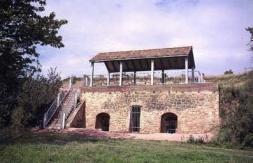The Limekilns

The History
Millions of years ago limestone developed from sedimentary deposition of shells and skeletons of organisms living in the sea and has been used as a building material for thousands of years. Before the introduction of cement people almost exclusively used lime as a binder for mortar. Lime results from the calcination of limestone in so-called limekilns. The oldest limekilns go back to the Babylonians in Mesopotamia (about 240 B.C.). The knowledge of how to produce lime came to us via Greeks and Romans. Roman buildings and afterwards churches and castles were erected with the help of lime mortar. But basically the manufacturing of lime has not changed.
The Design
The Eppelsheim limekilns are egg-shaped and perpendicular to the hillside. Thanks to their favourable position they could be loaded more easily and also be insulated more effectively. Crushed limestone from the close proprietary quarry or collected in the surrounding fields was filled into the funnels from above. The hollows in front of the ports were used to heat the kilns. When burnt through, the quicklime or burnt lime was cooled and raked out through the base. A projecting roof gave shelter to the workspace of the labourers from the elements. Likewise, it protected the lime from getting wet. The significance of the central chamber could not be found out.



